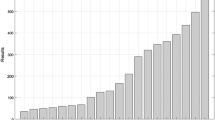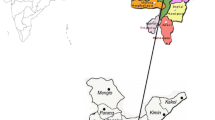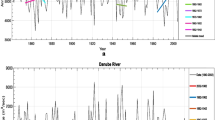Abstract
In the grey prediction, the GM(1, 1) model is an important type, but it sometimes shows big prediction errors. To improve the prediction precision of GM(1, 1) model, the paper makes improvements from the following three aspects: (1) to improve the data’s adaptability to the model, the paper transforms the accumulated generating sequence of original time sequence; (2) to make the model meet the variation characteristics of data, the paper extends the grey action of traditional GM(1, 1) model; (3) to avoid big average simulation or prediction relative error of model, the paper considers the minimum of the maximum of the two errors as the optimization objective function. The new extended grey model is called the GM(1, 1, exp × sin, exp × cos) model. The paper uses an improved particle swarm optimization (PSO) algorithm for the parameter optimization of GM(1, 1, exp × sin, exp × cos) model and thus improves the model’s convergence rate and precision. According to the model and method proposed, the paper builds a GM(1, 1, exp × sin, exp × cos) model for China’s GDP per capita. Results show that the model has high precision.

Similar content being viewed by others
Data availability
Enquiries about data availability should be directed to the authors.
References
Cai LL, Wu F, Lei DG (2021) Pavement condition index prediction using fractional order GM(1,1) model. IEEJ Trans Electr Electr Eng 16(8):1099–1103
Cao Y, Yin KD, Li XM (2020) Prediction of direct economic loss caused by marine disasters based on the improved GM(1,1) model. J Grey Syst 32(1):133–145
Chen FY, Zhu YP (2021) A new GM(1,1) based on piecewise rational linear. Eng Lett 29(3):849–855
Cheng ML, Cheng Z (2023) A novel simultaneous grey model parameter optimization method and its application to predicting private car ownership and transportation economy. J Ind Manage Optim 19(5): 3160–3171
Cheng ML, Liu B (2021) An extended grey GM(1,1) power model and its application. J Stat Inf 36(10):3–11
Ding S (2018) A novel self-adapting intelligent grey model for forecasting China’s natural-gas demand. Energy 162:393–407
Ding S (2019) A novel discrete grey multivariable model and its application in forecasting the output value of China’s high-tech industries. Comput Ind Eng 127:749–760
Fu ZW, Yang YK, Wang TY (2019) Prediction of urban water demand in Haiyan county based on improved nonlinear optimization GM(1, N) model. Water Resour Res 37(10):44–47
Hu YC (2020) Energy demand forecasting using a novel remnant GM(1,1) model. Soft Comput 24(18):13903–13912
Huang CJ, Cao YZ, Zhou L (2021) Application of optimized GM(1,1) model based on EMD in landslide deformation prediction. Comput Appl Math 40(8):261
Jiang YX, Zhang QS (2015) Background-value optimization of model GM(1,1). Chin J Manage Sci 23(9):146–151
Li B, Wei Y (2009) Optimizes grey derivative of GM(1,1). Syst Eng Theory Prac 29(2):100–105
Liu SF (2021) Grey system theory and its application, 9th edn. Science Press, Beijing
Liu Z, Xie YM, Dang YG (2019) A progress analysis of Chinese poverty alleviation based on improved GM(1,1). Syst Eng Theory Prac 39(1):2476–2486
Ma YM, Wang SC (2019) Construction and application of improved GM(1,1) power model. J Quant Econ 36(3):84–88
Mi CM, Wang YJ, Xiao L (2021) Prediction on transaction amounts of China’s CBEC with improved GM. Electron Commer Res 21(1):125–146
Qi Q, Li C (2021) Application of GM(1, 1) model based on background value optimization in China civil aviation freight volume forecast. Logist Eng Manage 43(10):56–59
Qian WY, Wang J (2020) An improved seasonal GM(1,1) model based on the HP filter for forecasting wind power generation in China. Energy 209:118499
Rathnayaka RMKT, Seneviratna DMKN (2020) Taylor series approximation based unbiased GM(1,1) hybrid statistical approach for forecasting stock market. J Grey Syst 32(3):124–133
Tang LW, Lu YY (2020) An improved non-equal interval GM(1,1) model based on grey derivative and accumulation. J Grey Syst 32(2):77–88
Tong Q (2021) Weighted non-equal interval gray GM(1,1) model based on function cot(xα) transformation and its application. Math Prac Theory 51(13):209–215
Wang ZX, Li Q (2019) Modelling the nonlinear relationship between CO2 emissions and economic growth using a PSO algorithm-based grey Verhulst model. J Clean Prod 207:214–224
Wang YH, Lu J (2020) Improvement and application of GM(1,1) model based on multivariable dynamic optimization. J Syst Eng Elect 31(3):593–601
Wang CS, Sun ZH (2021) Monthly pork price forecasting method based on Census X12-GM(1,1). PLoS ONE 16(5):1–13
Wang ZX, Zhao YF (2020) GM(1,1) model with seasonal dummy variables and its application. Syst Eng Theory Prac 40(11):2981–2990
Xie M, Wu LF (2021) Short-term traffic flow prediction based on GM(1, N) power model optimized by rough set algorithm. Math Prac Theory 51(09):241–249
Xu N, Dang YG (2015) An optimized grey GM(2,1) model and forecasting of highway subgrade settlement. Math Probl Eng 2015(1):1–6
Xu N, Dang YG (2018) Characteristic adaptive GM(1,1) model and forecasting of Chinese traffic pollution emission. Syst Eng Theory Prac 38(1):187–196
Xu N, Dang YG, Ding S (2015) Optimization method of background value in GM(1,1) model based on least error. Control Decis 30(2):283–288
Xu N, Dang YG, Gong YD (2016) Novel grey prediction model with nonlinear optimized time response method for forecasting of electricity consumption in China. Energy 118:1–8
Zeng B, Li C (2016) Forecasting the natural gas demand in China using a self-adapting intelligent grey model. Energy 112:810–825
Funding
This work was supported by National Natural Science Foundation of China (No.11401418).
Author information
Authors and Affiliations
Contributions
MC: Conceptualization, Methodology, Supervision, Project administration, Software, Writing–original draft. BL: Validation, Formal analysis, Investigation, Resources, Data curation, Visualisation.
Corresponding author
Ethics declarations
Conflict of interest
The authors have no relevant financial or non-financial interests to disclose.
Ethical approval
Not applicable. There is no human or animal involved in this research.
Informed consent
Not applicable. In this research, no human or animal is involved.
Additional information
Publisher's Note
Springer Nature remains neutral with regard to jurisdictional claims in published maps and institutional affiliations.
Rights and permissions
Springer Nature or its licensor (e.g. a society or other partner) holds exclusive rights to this article under a publishing agreement with the author(s) or other rightsholder(s); author self-archiving of the accepted manuscript version of this article is solely governed by the terms of such publishing agreement and applicable law.
About this article
Cite this article
Cheng, M., Liu, B. Application of a novel grey model GM(1, 1, exp × sin, exp × cos) in China’s GDP per capita prediction. Soft Comput 28, 2309–2323 (2024). https://doi.org/10.1007/s00500-023-09287-2
Accepted:
Published:
Issue Date:
DOI: https://doi.org/10.1007/s00500-023-09287-2




